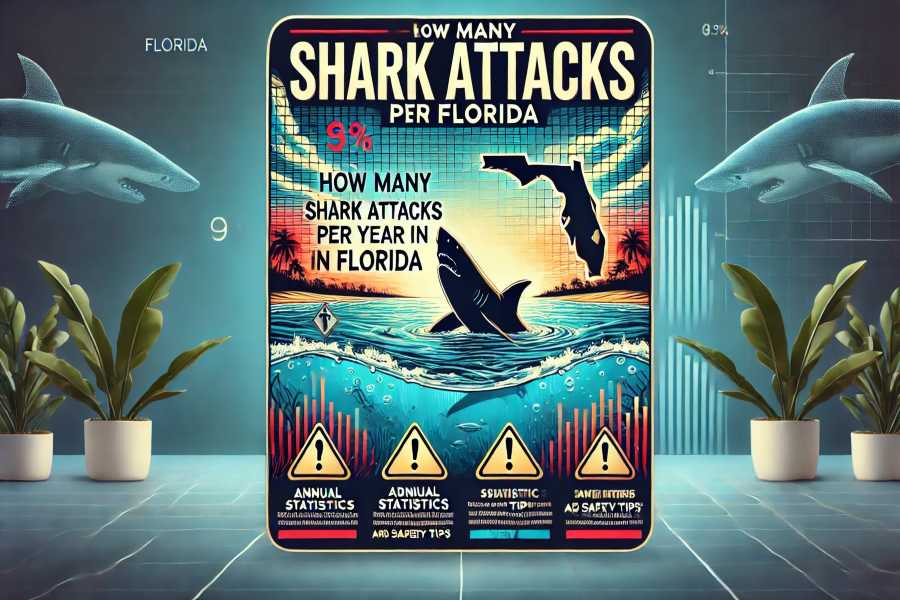
Florida is known for its glamorous beaches, but equally, it is known to be a state full of shark attacks. Given the fact that many people, both from within and out of state, often come to spend some time on these beaches, it becomes very important to analyze how often these attacks have taken place and under what conditions. One question that immediately comes to mind—especially if someone is about to visit the state of Florida—has to be, “How many shark attacks per year in Florida?”. In this article, we will go through the stats, analyze the trends, and give you some safety tips so that you can enjoy your time in Florida’s waters and stay safe. From a simple beachgoer and surfer to merely an interested person, this in-depth guide will help to enlighten your knowledge of shark attacks in Florida.
How Many shark Attacks per year in Florida?
The number of shark attacks happening per year in Florida varies, but on average, there are about 20-30 reported incidents annually. Florida constantly holds the number one spot in recorded unprovoked shark attacks worldwide. This could be attributed to the warm waters and the high volume of beach participants across Florida. Most of the attacks happen near the Atlantic coast and in Volusia County. Although such moments may send chills down your spinal cord, death from shark attacks is very rare. Following safety guidelines will reduce your potential risks of encountering a shark by avoiding swimming either during dusk or at dawn and keeping well away from fishing areas.
Shark Attacks in Florida Statistics
Florida has recorded the highest number of shark attacks in the United States. The state usually experiences around 20-30 unprovoked shark attacks every year, which is almost half of the total shark attacks occurring in the country. This has been highly periodic because of its long coastline, warm waters, and huge beach crowds. Volusia County is reported to have the most shark activities with New Smyrna Beach, hence earning the name “shark attack capital of the world.”.
The International Shark Attack File, which is a database in relation to shark attacks, indicates that Florida has maintained the top rate of shark attacks over the last couple of decades. A majority of the victims were surfing or swimming, with fewer cases involving divers and snorkelers; according to the database, the number of incidents, though generally high, only a few of these attacks have been fatal. Shark attacks, in most instances, are not serious and end up not causing much damage to the victim.
Knowing what contributes to shark attacks can help mitigate risks. Shark attacks are known to be more frequent in summer when the temperature of the water is high and more people are in the water. In addition, sharks are apparently attracted to areas where there is likely to be a lot of fish since they are their natural food. That is why it’s best to avoid fishing areas and times when fish are more active—like at dawn and dusk—to reduce the chance of an encounter.
In the past years, much focus has been on shark conservation since the majority of shark species are under threat from overfishing and habitat loss. The conservation efforts have led to a better understanding of shark behavior and strategies for minimizing human-shark interactions. Knowing some of these facts and using particular precautions ensures that beachgoers can enjoy Florida’s waters while reducing their risk of a shark attack.
Factors Influencing Shark Attacks
Factors Relating to Time and Location
Many factors can contribute to shark attacks in Florida. The most relevant ones concern time of day and location. Most attacks happen between 8 AM and 6 PM when the beaches are most crowded. The times of activity by sharks are in the early morning and late afternoon, coinciding with the feeding times according to the activity patterns of their prey.
Beach and Water Activities
Not all water activities expose one to the same level of risk. Surfing presents the highest magnitude of shark attacks since surfers, due to the way they paddle and lie on their boards, often resemble prey in shape. Swimmers and snorkelers are also at risk, but to a lesser degree. One can minimize the potential for an encounter by not making splashy or erratic movements.
Environmental Conditions
Water temperature and clarity relate to shark attacks: warmer waters increase shark counts, and low-visibility waters can facilitate mistaken identity bites. Swim in very clear and very calm waters to help minimize your risk of an attack.
Human Behavior and Precautions
Human behavior may account for up to 90% of shark attack incidents. Ignoring safety warnings or swimming alone or too far from shore could raise encounter probability. Following the safety guidelines and being precautionary of the surroundings is the basic rule for preventing shark attacks.
Shark Conversation and Human Interaction
Conservation efforts for sharks have made it easier to understand shark behavior and the way sharks relate with human beings. In terms of safety and also with respect toward marine life, it is a question of keeping the right distance from sharks.
Analysis of Historical Shark Attacks Data
It is also meaningful to look at the historical data on shark attacks that happened in Florida to obtain trend and pattern insight. While during the last few decades the number of shark attacks remained almost the same, there are visible fluctuations, which are in fact caused by both environmental and human factors. Understanding those trends may be helpful in developing appropriate prevention measures.
Seasonal Variations: Shark attacks in Florida clearly indicate a seasonal pattern. Most of the attacks occur during the summer months—June to September. This period is also associated with peak beach season, and increased water temperatures also correlate with the presence of migratory shark species.
Geographical Distribution: Volusia County, more precisely New Smyrna Beach, holds the largest portion of shark attacks. This area is significant for shark density and surfing activity. Other prominent spots are Brevard, Palm Beach, Martin counties.
Shark species involved: The most common invading species of sharks in Florida are blacktip shark, bull shark, and spinner shark. These species commonly occur in coastal waters and are often caught nearshore, where they come into contact with man.
Demographics of Victims: Surfers and young males are known to be the common victims of shark bites in Florida. This is because that demographic segment has a greater propensity to engage in activities that expose them to a higher possibility of shark encounters. Understanding who the typical victim might be can be beneficial in designing or being oriented toward target education for prevention.
Effects of Conservation Programs: Shark conservation has brought about increasing knowledge regarding shark behavior and reduced human-shark conflicts. Protecting the shark populations and their range is important in keeping balance at sea and ensuring human safety.
Shark Attack Prevention Measures
- Public Education and Awareness: The public can be made aware of the shark behavior and safety measures to be followed to avert the attacks. This can be done through educational campaigns as well as by displaying cautionary signs on beaches to educate people about potential risks and safety measures.
- Technological Innovations: Shark detection and deterrent technologies have slackened up considerably in recent years. They include drones, sonar systems, and electronic deterrents Continuous monitoring of shark activity by systems to alert beachgoers in real-time.
- Beach Safety Protocols: The risk of shark attack can be lessened by the implementation and enforcement of strict beach safety protocols. Regular patrols clearly displayed safety signposts, and marked-out swimming areas are part of the protocols. The basis of the safety of beach-goers lies at the hands of the lifeguard.
- Research and Discussion: Internet research on shark behavior and habitat is the most effective means towards prevention. Shark population conservation hence takes a corrective stance in human-shark confrontations.
- Community Involvement: Sensitizing local communities to shark conservation and security makes them responsible and collaborative in society. Community-driven projects can thus share information and promote safe habits.
Conclusion
Knowing exactly how many shark attacks occur in Florida each year and what contributes to them is important information that equally applies to its residents and visitors. By being more aware and acting with caution, with a little help from conservation efforts, people should be able to coexist peacefully with one of the ocean’s most fascinating predators while minimizing their chance of becoming one of the victims in the long list of shark attack incidents.
Frequently Asked Questions:
Q. How many shark attacks occur in Florida each year?
A. Florida has some 20-30 unprovoked shark attacks annually.
Q. Which area in Florida has the most shark attacks?
A. Volusia County, especially New Smyrna Beach, holds the highest number of shark attacks within Florida.
Q. What time of year are Florida shark attacks most prevalent?
A. Shark attacks are most prevalent during the summer months, particularly July through September.
Q. What species of sharks are most commonly involved in Florida attacks?
A. Blacktip shark, bull shark, and spinner shark are common attacking species.





